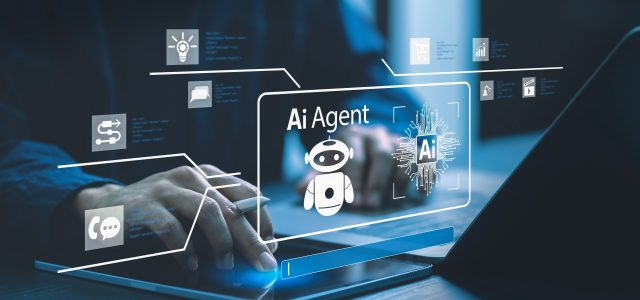As AI agents continue to evolve from research concepts into production-ready solutions, open-source frameworks are playing a pivotal role in accelerating adoption. Whether you’re building autonomous systems, LLM-powered applications, or orchestrating multi-agent collaboration, having the right AI agent framework is essential. In this blog, we’ve curated 10 of the most notable open-source AI agent frameworks to watch in 2025. These projects are actively maintained, widely adopted, and cater to diverse use cases in the AI development lifecycle.
In-person conference | May 13th-15th, 2025 | Boston, MA
Join us May 13th-15th, 2025, for 3 days of immersive learning and networking with AI experts.
🔹 World-class AI experts | 🔹 Cutting-edge workshops | 🔹 Hands-on Training
🔹 Strategic Insights | 🔹 Thought Leadership | 🔹 And much more!
1. LangChain
Use case: LLM-powered applications, prompt chaining, tool usage, memory management
GitHub Stars: ★ 70k+
Githubub: LangChain
LangChain has established itself as the go-to toolkit for building applications with large language models. Its modular structure makes it easy to chain prompts, integrate external tools, and manage conversational memory. LangChain supports both synchronous and asynchronous workflows, making it suitable for production-grade pipelines. With a vibrant ecosystem and extensive documentation, it remains a foundational framework for LLM application development.
2. Auto-GPT
Use case: Autonomous task execution using GPT
Key Features: Recursion, memory, web browsing, file handling
Githubub: Auto-GPT
Auto-GPT sparked mainstream interest in autonomous agents in 2023 by showcasing how GPT models could be looped to perform tasks with minimal human input. It introduces recursive execution, persistent memory, and access to tools like web browsers and file systems. Ideal for those looking to explore AI systems that plan and act independently, this AI agent framework continues to influence new agent designs.
3. AGEGPT
Use case: Browser-based agent creation
Focus: UI for deploying Auto-GPT-style agents
Githubub: Agency
AgentGPT brings autonomous agents to the browser, offering a simple, UI-driven interface to spin up agents without writing code. It is geared toward experimentation and quick deployments, making it a popular choice for demos and non-technical users exploring AI agent behavior in a visual environment.
4. Crewai
Use case: Multi-agent collaboration
Key Features: Role-based agent assignments (e.g., researcher, writer, analyst)
Githubub: Creewai
CrewAI focuses on team-based agent collaboration, assigning distinct roles to agents to complete complex workflows. This coordination mimics real-world teams and allows for better specialization and task division. It’s a strong fit for data science and content creation projects requiring coordinated agent efforts.
5. MetaGPT
Use case: Autonomous coding team simulation
Focus: Build software projects with the CEO, PM, and Dev agents
Githubub: MetaGPT
MetaGPT simulates the structure of a software development team, automating workflows through agents acting as CEO, project manager, and developers. By orchestrating these roles, this AI agent framework can ideate, plan, and build software products with minimal human oversight. It’s particularly appealing for AI engineers exploring autonomous software development pipelines.
Level Up Your AI Expertise! Subscribe Now:
![]()
![]()
6. Camel Ai (camel)
Use case: Role-playing multi-agent simulations
Focus: Agent-to-agent conversation to solve tasks
Githubub: CAMEL
CAMEL introduces a novel concept: agents role-play to solve tasks collaboratively. One agent might take the role of a user while another plays the assistant, and their dialogue drives the problem-solving process. This conversational dynamic has implications in training, simulations, and AI alignment research.
7. Babyagi
Use case: Autonomous task management
Key Features: Task planning, prioritization, execution, and memory loop
Githubub: Babyagi
BabyAGI simplifies the concept of AGI through a compact task-planning loop. It generates, prioritizes, and executes tasks while learning from previous outputs. Designed to be lightweight, it serves as a foundational agent template for small-scale autonomous systems.
8. Supragi
Use case: Full-stack agent infrastructure
Key Features: GUI, toolkits, vector database integration
Githubub: Superagi
SuperAGI is designed as a production-ready framework with a focus on extensibility. Its graphical interface, combined with support for multiple tools, memory systems, and APIs, enables developers to prototype and scale agents with ease. SuperAGI is ideal for enterprise-grade applications needing robust backend integration.
9. AutoGen by Microsoft
Use case: LLM orchestration with collaborative agents
Key Features: Multi-agent chat, function calling, simulation of social dynamics
Githubub: Autogenic
AutoGen is Microsoft’s entry into multi-agent orchestration. It enables structured interactions between agents using predefined roles and collaborative chat logic. Features like function calling and fine-grained control over agent dialogue make it particularly suitable for research and enterprise prototyping alike.
10. Open Agents (formerly OpenDevin)
Use case: Developer-focused agent framework
Focus: AI-powered software development and debugging
Githubub: Open Agents
Open Agents was designed with developers in mind. With a focus on building and debugging code through natural language instructions, this framework provides an AI-enhanced development environment. The agent can plan, edit, and execute code within a controlled sandbox, making it a promising tool for AI-first programming workflows.
In-person conference | May 13th-15th, 2025 | Boston, MA
Join us at ODSC East for hands-on training, workshops, and bootcamps with the leading experts. Topics include:
🔹 Introduction to scikit-learn
🔹 Building a Multimodal AI Assistant
🔹 Explainable AI for Decision-Making Applications
🔹 Building and Deploying LLM Applications
🔹 Causal you have
🔹 Adaptive RAG Systems with Knowledge Graphs
🔹 Idiomatic Polars
🔹 Machine Learning with CatBoost
Final Thoughts
As AI agents shift from experimental to essential tools in development pipelines, understanding the right AI agent framework for your use case is key. From autonomous coding teams to collaborative research assistants, the open-source ecosystem in 2025 offers a wide array of capabilities for developers, data scientists, and AI practitioners.
For those looking to deepen their practical skills and gain hands-on experience with AI agent frameworks and LLM orchestration, consider enrolling in the ODSC 5-Week Spring AI Bootcamp. This immersive course offers real-world projects, industry insights, and mentorship to help you transition from foundational knowledge to applied AI engineering.
Sign up now and join the bootcamp here today: https://app.aiplus.training/courses/odsc-2025-5-week-spring-ai-bootcamp
Now is the time to get ahead of the curve. Explore these frameworks, experiment with building agents, and equip yourself with the skills to thrive in the evolving AI landscape.
For more info visit at Times Of Tech







